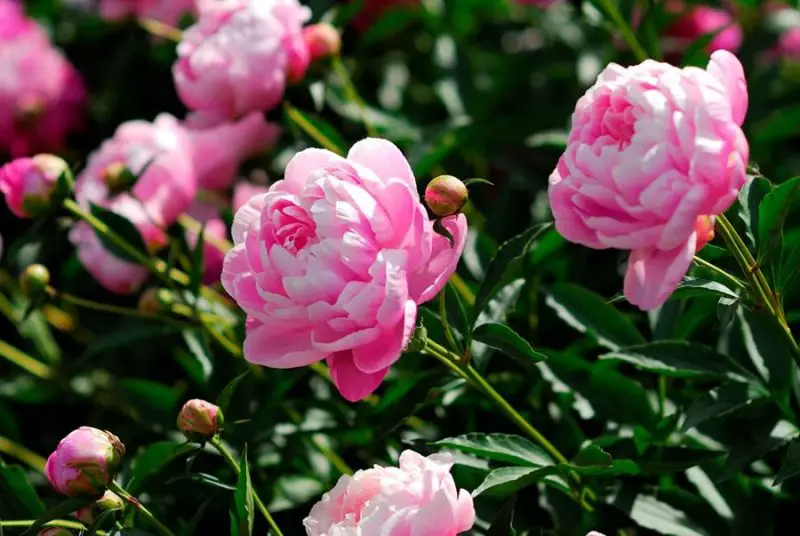Peonies are among the most beloved perennial flowers, prized for their lush, fragrant blooms and timeless beauty in spring and early summer gardens. While their blooming period may seem brief, understanding when peonies bloom in your specific region can help you plan your garden for maximum impact. Because climate, elevation, and planting zones all influence bloom time, it’s important to know the regional factors that affect when your peonies will put on their show.
Across the United States and other temperate regions, peonies typically bloom from late April to early June. However, this window shifts depending on your USDA hardiness zone, your local microclimate, and the type of peony you’re growing. Whether you’re in the southern states where blooms begin early or in the northern zones where they appear later, there are ways to anticipate, extend, and enjoy the full potential of your peony bloom season.
In this guide, we’ll explore peony bloom times by region, including climate considerations, zone-specific advice, and how to choose cultivars that thrive in your area. We’ll also provide insight into the types of peonies and their bloom sequences, so you can create a season filled with these spectacular flowers.
Understanding Peony Bloom Cycles

Peonies follow a natural blooming progression that begins in spring and can last several weeks. Depending on the cultivar, peonies are classified into early-blooming, mid-season, or late-blooming types. This staggered timing allows gardeners to enjoy a prolonged peony display with careful planning. Typically, early varieties start blooming in late April or early May, while late-season varieties can bloom into June in cooler regions.
Environmental cues such as soil temperature, daylight length, and accumulated chill hours during winter all influence when peonies break dormancy and begin to flower. While peonies require a cold period to bloom properly, too much warmth early in spring can also affect their flowering rhythm. This makes regional timing especially important, as peonies will respond to your local climate in unique ways.
By selecting different bloom-time cultivars and understanding how your zone influences flowering, you can plan a peony garden that unfolds gradually and fills your spring landscape with rich, romantic color.
Peony Bloom Time in Northern Regions (Zones 3–5)
In colder climates, such as parts of the Upper Midwest, New England, and much of Canada, peony bloom time typically begins later in the season. Gardeners in USDA zones 3 to 5 often see their peonies bloom in late May through mid-June. Because of the long, cold winters and late thaws in these areas, peonies break dormancy more slowly and bloom later than in warmer climates.
In Zone 3 areas such as northern Minnesota or parts of Montana, peonies may not begin flowering until the first or second week of June. Zone 4 regions, which include parts of Wisconsin and northern New York, may see blooms start in late May. Zone 5 gardeners, including areas like Chicago and southern Michigan, often enjoy a bloom window that opens in the final week of May and lasts into early June.
Cooler zones offer a distinct advantage when it comes to peony health. These climates provide the extended chill that peonies need to produce strong buds and vibrant flowers. Peonies in these areas tend to be long-lived and require less division or rejuvenation than those in warmer zones.
To get the most out of your bloom season in colder regions, it’s advisable to plant a mix of early, mid, and late-blooming peonies. By doing so, you can stretch the peony season over a full four to five weeks and ensure your garden is filled with blooms throughout the early summer.
Bloom Timing in the Mid-Atlantic and Midwest (Zones 5–6)
In USDA zones 5 and 6, which include much of the Midwest and Mid-Atlantic regions such as Pennsylvania, Ohio, Indiana, and parts of Missouri, peonies begin blooming in mid-to-late May. These zones offer some of the best conditions for peonies, combining cool winters with moderate spring temperatures that encourage healthy flower development.
Peonies in these regions are among the most reliable bloomers, often flowering right on schedule once soil temperatures rise consistently above 55°F (13°C). Gardeners in zone 6 may begin seeing early varieties open in mid-May, with mid-season types following by late May and late bloomers extending into early June.
Because spring in these regions can be unpredictable—with sudden cold snaps or bursts of heat—it’s important to monitor soil moisture and provide mulch in early spring. Mulching not only regulates temperature but also keeps weeds at bay, ensuring that peonies have optimal growing conditions during the weeks leading up to bloom.
These zones also offer opportunities to plant peonies in both full sun and light shade. While peonies generally prefer six to eight hours of sunlight per day, slightly shaded locations in warmer microclimates can help extend bloom time and prevent flowers from fading too quickly in the sun.
Peony Blooming in the South and Southeast (Zones 7–8)
Gardeners in the southern U.S., including regions like Georgia, North Carolina, and northern parts of Florida and Texas, often wonder whether peonies can thrive in their warmer climates. While peonies do need winter chill to bloom successfully, certain cultivars can perform well in USDA zones 7 and 8. In these areas, peonies tend to bloom earlier, often beginning in late April and peaking by early or mid-May.
Because spring arrives earlier in the South, peonies emerge from dormancy quickly and race into bloom ahead of their northern counterparts. However, the warmer spring temperatures can also shorten the bloom period, especially if days are consistently above 80°F (27°C). To mitigate this, gardeners in these regions should focus on planting peonies in locations with morning sun and afternoon shade, protecting them from the harshest heat of the day.
Tree peonies and intersectional (Itoh) hybrids are particularly suited to Southern gardens, as many of these types tolerate heat better than herbaceous varieties. Mulching is also essential in the South—not only to conserve soil moisture but to shield peony roots from temperature fluctuations.
By selecting cultivars known for heat tolerance and providing thoughtful siting, gardeners in zones 7 and 8 can enjoy a lush and rewarding peony bloom season, even in climates not traditionally associated with this cool-loving plant.
Peony Bloom Time in the Pacific Northwest (Zones 7–8)
The Pacific Northwest, with its mild winters and moist springs, offers a unique setting for peony cultivation. In cities like Seattle, Portland, and Eugene, peonies often begin blooming in late April or early May, depending on elevation and local weather patterns. While these regions fall within USDA zones 7 and 8, their cooler maritime influence creates conditions closer to northern climates.
Peonies thrive in the well-drained soils and steady spring temperatures of the Pacific Northwest. The abundant rainfall helps maintain soil moisture, and overcast skies can extend the life of the flowers by shielding them from harsh sunlight. Gardeners in this region typically enjoy a bloom season that lasts well into May and occasionally into early June for late-season varieties.
Because of the wet spring conditions, it’s important to ensure good air circulation around peony plants to prevent fungal diseases such as botrytis blight. Proper spacing, thinning of foliage, and planting in areas with good drainage are key strategies for maintaining healthy plants throughout the bloom season.
The diversity of microclimates in this region also allows for experimentation with different peony types. Herbaceous peonies do well here, but tree peonies can also thrive in sheltered spots, offering blooms that appear even earlier in the spring.
Western and Mountain Regions (Zones 4–7)
In the Western and Mountain states such as Colorado, Utah, and parts of northern California, peony bloom time varies widely depending on elevation and local climate conditions. Lower elevations in these states may see peonies blooming by mid-May, while higher elevations can delay bloom until early or even mid-June.
The dry air and cooler nights of mountainous regions help preserve bloom quality and color. Peonies planted in these areas often have strong stems and vivid flowers, thanks to the wide daily temperature fluctuations. However, gardeners must be vigilant about watering, as spring droughts are not uncommon in western regions.
Wind protection is another consideration in mountainous areas. Since peony blooms are large and can be top-heavy, planting them in locations with some wind shelter helps maintain upright, tidy plants. Gardeners should also provide support structures for taller peony cultivars to prevent lodging from sudden windstorms or heavy rains.
With proper care and attention to microclimate variations, peonies in these zones can be just as stunning as those in more temperate regions. The bloom window may be shorter due to unpredictable weather, but the quality of the blossoms is often unmatched.
How to Extend Your Peony Bloom Season
To make the most of peony season regardless of your region, one effective strategy is to select peonies that bloom at different times. By planting a mix of early, mid-season, and late varieties, gardeners can enjoy continuous peony blooms for up to six weeks.
In addition to choosing the right cultivars, providing ideal growing conditions helps prolong the bloom period. Peonies prefer full sun in most regions, but afternoon shade can help prevent blooms from fading in hotter climates. Regular watering during the bud stage, combined with soil rich in organic matter, encourages lush, long-lasting flowers.
Deadheading spent blooms also improves the garden’s appearance and can reduce the risk of disease. While peonies don’t rebloom in the same season, healthy plants will return stronger each year if cared for properly. Avoid cutting back foliage until it has fully yellowed in fall, as the plant needs time to store energy for the next year’s flowers.
With the right planting techniques, cultivar selection, and maintenance habits, your peony garden can provide a vibrant and prolonged display season after season.
Frequently Asked Questions About When Peonies Bloom
What month do peonies typically bloom?
Peonies usually bloom between late April and early June, depending on your location and the specific cultivar. In warmer southern regions, they may bloom as early as April, while in northern climates, blooms often appear in late May or June.
How long do peony flowers stay in bloom?
Each individual peony flower lasts about 7 to 10 days, but you can extend the overall bloom season to 4 to 6 weeks by planting a combination of early, mid-season, and late-blooming varieties in your garden.
Do peonies bloom in their first year after planting?
Most peonies do not bloom in their first year. It usually takes 2 to 3 years for peonies to become established and produce full blooms. During this time, the plant focuses on root development and foliage growth.
Can I make peonies bloom earlier?
You can encourage earlier blooms by planting early-season cultivars and placing them in full sun. However, peonies are highly dependent on natural climate cues, so their bloom time is difficult to force without greenhouse conditions.
Why are my peonies not blooming?
Peonies may fail to bloom due to insufficient sunlight, planting too deep, immature plants, or a lack of winter chill. Make sure they receive at least 6 hours of direct sunlight and are planted with their eyes (buds) just 1–2 inches below the soil surface.
What are the best zones for peony blooming?
Peonies grow and bloom best in USDA zones 3 to 7, where they receive enough winter chill to set buds. Some cultivars can bloom in zone 8 with proper care and site selection, but they are less reliable in hot or tropical climates.
Do different types of peonies bloom at different times?
Yes, there are early-blooming, mid-season, and late-blooming peony varieties. By mixing types such as herbaceous, tree, and intersectional (Itoh) peonies, you can create a longer-lasting bloom period in your garden.
Conclusion: Know Your Region, Know Your Peonies
The key to a successful peony garden lies in understanding when peonies bloom in your specific region. From the late bloomers of northern states to the early risers in the South, peony timing is closely tied to climate and zone. By familiarizing yourself with your USDA zone and choosing cultivars suited to your conditions, you’ll be rewarded with breathtaking blooms that mark the highlight of the spring garden.
Planning your peony plantings with regional timing in mind allows you to enjoy a longer bloom window, healthier plants, and a more spectacular floral show. Whether you’re growing herbaceous peonies in a Zone 5 backyard or experimenting with tree peonies in Zone 8, the beauty and charm of peonies remain timeless across all regions.






